Phrygia
hideThis article has multiple issues. Please help or discuss these issues on the talk page. (Learn how and when to remove these template messages)
|
| Phrygia | |
|---|---|
| Ancient Kingdom of Anatolia | |
| Location | Central Anatolia |
| Language | Phrygian |
| State existed | Dominant kingdom in Asia Minor from c. 1200–700 BC |
| Capital | Gordium |
| Persian satrapy | Hellespontine Phrygia, Greater Phrygia |
| Roman province | Galatia, Asia |
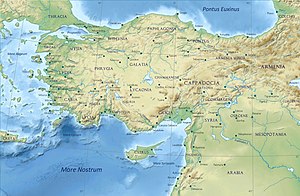 | |
| Part of a series on |
| Indo-European topics |
|---|
 |
In classical antiquity, Phrygia (/ˈfrɪdʒiə/; Ancient Greek: Φρυγία, Phrygía [pʰryɡía]; Turkish: Frigya) (also known as the Kingdom of Muska)[1] was a kingdom in the west central part of Anatolia, in what is now Asian Turkey, centred on the Sangarios River. After its conquest, it became a region of the great empires of the time.
Stories of the heroic age of Greek mythology tell of several legendary Phrygian kings:
- Gordias, whose Gordian Knot would later be cut by Alexander the Great
- Midas, who turned whatever he touched to gold
- Mygdon, who warred with the Amazons
According to Homer's Iliad, the Phrygians participated in the Trojan War as close allies of the Trojans, fighting against the Achaeans. Phrygian power reached its peak in the late 8th century BC under another, historical, king: Midas, who dominated most of western and central Anatolia and rivaled Assyria and Urartu for power in eastern Anatolia. This later Midas was, however, also the last independent king of Phrygia before Cimmerians sacked the Phrygian capital, Gordium, around 695 BC. Phrygia then became subject to Lydia, and then successively to Persia, Alexander and his Hellenistic successors, Pergamon, the Roman Empire and the Byzantine Empire. Over this time Phrygians became Christian and Greek-speaking, assimilating into the Byzantine state; after the Turkish conquest of Byzantine Anatolia in the late Middle Ages, the name "Phrygia" passed out of usage as a territorial designation.
Geography[]
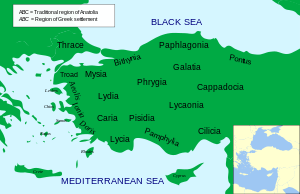

Phrygia describes an area on the western end of the high Anatolian plateau, an arid region quite unlike the forested lands to the north and west of it. Phrygia begins in the northwest where an area of dry steppe is diluted by the Sakarya and Porsuk river system and is home to the settlements of Dorylaeum near modern Eskişehir, and the Phrygian capital Gordion. The climate is harsh with hot summers and cold winters. Therefore, olives will not easily grow here so the land is mostly used for livestock grazing and barley production.
South of Dorylaeum, there an important Phrygian settlement, Midas City (Yazılıkaya, Eskişehir), is situated in an area of hills and columns of volcanic tuff. To the south again, central Phrygia includes the cities of Afyonkarahisar (ancient Akroinon) with its marble quarries at nearby Docimium (İscehisar), and the town of Synnada. At the western end of Phrygia stood the towns of Aizanoi (modern Çavdarhisar) and Acmonia. From here to the southwest lies the hilly area of Phrygia that contrasts to the bare plains of the region's heartland.
Southwestern Phrygia is watered by the Maeander (Büyük Menderes River) and its tributary the Lycus, and contains the towns of Laodicea on the Lycus and Hierapolis.[2]
Origins[]
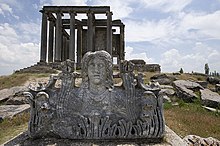

Legendary ancient migrations[]
According to ancient tradition among Greek historians, the Phrygians anciently migrated to Anatolia from the Balkans. Herodotus says that the Phrygians were called Bryges when they lived in Europe.[3] He and other Greek writers also recorded legends about King Midas that associated him with or put his origin in Macedonia; Herodotus, for example, says a wild rose garden in Macedonia was named after Midas.[4]
Some classical writers[which?] also connected the Phrygians with the Mygdones, the name of two groups of people, one of which lived in northern Macedonia and another in Mysia. Likewise, the Phrygians have been identified[by whom?] with the Bebryces, a people said to have warred with Mysia before the Trojan War and who had a king named Mygdon at roughly the same time as the Phrygians were said to have had a king named Mygdon.
The classical historian Strabo groups Phrygians, Mygdones, Mysians, Bebryces and Bithynians together as peoples that migrated to Anatolia from the Balkans.[5] This image of Phrygians as part of a related group of northwest Anatolian cultures seems the most likely explanation for the confusion over whether Phrygians, Bebryces and Anatolian Mygdones were or were not the same people.
Phrygian language[]
Phrygian continued to be spoken until the 6th century AD, though its distinctive alphabet was lost earlier than those of most Anatolian cultures.[2] One of the Homeric Hymns describes the Phrygian language as not mutually intelligible with that of Troy,[6] and inscriptions found at Gordium make clear that Phrygians spoke an Indo-European language with at least some vocabulary similar to Greek. Phrygian clearly did not belong to the family of Anatolian languages spoken in most of the adjacent countries, such as Hittite.[7][8] The apparent similarity of the Phrygian language to Greek and its dissimilarity with the Anatolian languages spoken by most of their neighbors is also taken as support for a European origin of the Phrygians.[2]

Eric P. Hamp in his 2012 Indo-European family tree classified the Phrygian language together with Italo-Celtic as a member of a "Northwest Indo-European" group.[9] In Hamp's view, Northwest Indo-Europeans are likely to have been the first inhabitants of Hallstatt with the Pre-Phrygians moving east and south to Anatolia in the same manner as the Galatians did later on.[9] In 2010, Raymund Carl mentions that the Lausitz culture was one such Hallstatt-associated culture.[10]
Recent migration hypotheses[]
Some scholars dismiss the claim of a Phrygian migration as a mere legend, likely arising from the coincidental similarity of their name to the Bryges, and have theorized that migration into Phrygia could have occurred more recently than classical sources suggest. They have sought to fit the Phrygian arrival into a narrative explaining the downfall of the Hittite Empire and the end of the high Bronze Age in Anatolia,.[11]
According to the "recent migration" theory, the Phrygians invaded just before or after the collapse of the Hittite Empire at the beginning of the 12th century BC, filling the political vacuum in central-western Anatolia, and may have been counted among the "Sea Peoples" that Egyptian records credit with bringing about the Hittite collapse. The so-called Handmade Knobbed Ware found in Western Anatolia during this period has been tentatively identified as an import connected to this invasion.
Relation to their Hittite predecessors[]
Some scholars accept as factual the Iliad's account that the Phrygians were established on the Sakarya River before the Trojan War, and thus must have been there during the later stages of the Hittite Empire, and probably earlier, and consequently dismiss proposals of recent immigration to Phrygia. These scholars seek instead to trace the Phrygians' origins among the many nations of western Anatolia who were subject to the Hittites.[12] This interpretation also gets support from Greek legends about the founding of Phrygia's main city Gordium by Gordias and of Ancyra by Midas,[13] which suggest that Gordium and Ancyra were believed to date from the distant past before the Trojan War.
No one has conclusively identified which of the many subjects of the Hittites might have represented early Phrygians. According to a classical tradition, popularized by Josephus, Phrygia can be equated with the country called Togarmah by the ancient Hebrews, which has in turn been identified as the Tegarama of Hittite texts and Til-Garimmu of Assyrian records. Josephus called Togarmah "the Thrugrammeans, who, as the Greeks resolved, were named Phrygians". However, the Greek source cited by Josephus is unknown, and it is unclear if there was any basis for the identification other than name similarity.
Scholars of the Hittites believe Tegarama was in eastern Anatolia – some locate it at Gurun – far to the east of Phrygia. Some scholars have identified Phrygia with the Assuwa league, and noted that the Iliad mentions a Phrygian (Queen Hecuba's brother) named Asios.[14] Another possible early name of Phrygia could be Hapalla, the name of the easternmost province that emerged from the splintering of the Bronze Age western Anatolian empire Arzawa. However, scholars are unsure if Hapalla corresponds to Phrygia or to Pisidia, further south.
Relation to Armenians[]
Ancient Greek historian Herodotus (writing circa 440 BCE), suggested that Armenians migrated from Phrygia, which at the time encompassed much of western and central Anatolia: "the Armenians were equipped like Phrygians, being Phrygian colonists" (7.73) (Ἀρμένιοι δὲ κατά περ Φρύγες ἐσεσάχατο, ἐόντες Φρυγῶν ἄποικοι.) According to Herotodus, the Phrygians had originated in the Balkans, in an area adjoining Macedonia, from where they had emigrated to Anatolia during the Bronze Age collapse. This led later scholars, such as Igor Diakonoff, to theorize that Armenians also originated in the Balkans and moved east with the Phrygians.[15] However, an Armenian origin in the Balkans, although once widely accepted, has been facing increased scrutiny in recent years due to discrepancies in the timeline and lack of genetic and archeological evidence.[16][17][18] In fact, some scholars have suggested that the Phrygians and/or the apparently related Mushki people were originally from Armenia and moved westward.[19]
A number of linguists have rejected a close relationship between Armenian and Phrygian, despite saying that the two languages do share some features.[20][21][22][23][24] Phrygian is now classified as a centum language more closely related to Greek than Armenian, whereas Armenian is mostly satem.[25]
History[]
Around the time of the Trojan war[]
According to the Iliad, the homeland of the Phrygians was on the Sangarius River, which would remain the centre of Phrygia throughout its history. Phrygia was famous for its wine and had "brave and expert" horsemen.
According to the Iliad, before the Trojan War, a young king Priam of Troy had taken an army to Phrygia to support it in a war against the Amazons. Homer calls the Phrygians "the people of and godlike Mygdon".[26] According to Euripides, Quintus Smyrnaeus and others, this Mygdon's son, Coroebus, fought and died in the Trojan War; he had sued for the hand of the Trojan princess Cassandra in marriage. The name Otreus could be an eponym for Otroea, a place on Lake Ascania in the vicinity of the later Nicaea, and the name Mygdon is clearly an eponym for the Mygdones, a people said by Strabo to live in northwest Asia Minor, and who appear to have sometimes been considered distinct from the Phrygians.[27] However, Pausanias believed that Mygdon's tomb was located at Stectorium in the southern Phrygian highlands, near modern Sandikli.[28]
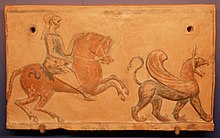
According to the Bibliotheca, the Greek hero Heracles slew a king Mygdon of the Bebryces in a battle in northwest Anatolia that if historical would have taken place about a generation before the Trojan War. According to the story, while traveling from Minoa to the Amazons, Heracles stopped in Mysia and supported the Mysians in a battle with the Bebryces.[29] According to some interpretations, Bebryces is an alternate name for Phrygians and this Mygdon is the same person mentioned in the Iliad.
King Priam married the Phrygian princess Hecabe (or Hecuba[30]) and maintained a close alliance with the Phrygians, who repaid him by fighting "ardently" in the Trojan War against the Greeks. Hecabe was a daughter of the Phrygian king Dymas, son of Eioneus, son of Proteus. According to the Iliad, Hecabe's younger brother Asius also fought at Troy (see above); and Quintus Smyrnaeus mentions two grandsons of Dymas that fell at the hands of Neoptolemus at the end of the Trojan War: "Two sons he slew of Meges rich in gold, Scion of Dymas – sons of high renown, cunning to hurl the dart, to drive the steed in war, and deftly cast the lance afar, born at one birth beside Sangarius' banks of Periboea to him, Celtus one, and Eubius the other." , father of the maiden Tecmessa, is mentioned as another mythical Phrygian king.
There are indications in the Iliad that the heart of the Phrygian country was further north and downriver than it would be in later history. The Phrygian contingent arrives to aid Troy coming from Lake Ascania in northwest Anatolia, and is led by Phorcys and Ascanius, both sons of Aretaon.
In one of the so-called Homeric Hymns, Phrygia is said to be "rich in fortresses" and ruled by "famous ".[6]
Peak and destruction of the Phrygian kingdom[]

During the 8th century BC, the Phrygian kingdom with its capital at Gordium in the upper Sakarya River valley expanded into an empire dominating most of central and western Anatolia and encroaching upon the larger Assyrian Empire to its southeast and the kingdom of Urartu to the northeast.
According to the classical historians Strabo,[31] Eusebius and Julius Africanus, the king of Phrygia during this time was another Midas. This historical Midas is believed to be the same person named as Mita in Assyrian texts from the period and identified as king of the Mushki. Scholars figure that Assyrians called Phrygians "Mushki" because the Phrygians and Mushki, an eastern Anatolian people, were at that time campaigning in a joint army.[32] This Midas is thought to have reigned Phrygia at the peak of its power from about 720 BC to about 695 BC (according to Eusebius) or 676 BC (according to Julius Africanus). An Assyrian inscription mentioning "Mita", dated to 709 BC, during the reign of Sargon of Assyria, suggests Phrygia and Assyria had struck a truce by that time. This Midas appears to have had good relations and close trade ties with the Greeks, and reputedly married an Aeolian Greek princess.
A system of writing in the Phrygian language developed and flourished in Gordium during this period, using a Phoenician-derived alphabet similar to the Greek one. A distinctive Phrygian pottery called Polished Ware appears during this period.
However, the Phrygian Kingdom was then overwhelmed by Cimmerian invaders, and Gordium was sacked and destroyed. According to Strabo and others, Midas committed suicide by drinking bulls' blood.

A series of digs have opened Gordium as one of Turkey's most revealing archeological sites. Excavations confirm a violent destruction of Gordium around 675 BC. A tomb from the period, popularly identified as the "Tomb of Midas", revealed a wooden structure deeply buried under a vast tumulus, containing grave goods, a coffin, furniture, and food offerings (Archaeological Museum, Ankara).
As a Lydian province[]
After their destruction of Gordium, the Cimmerians remained in western Anatolia and warred with Lydia, which eventually expelled them by around 620 BC, and then expanded to incorporate Phrygia, which became the Lydian empire's eastern frontier. The Gordium site reveals a considerable building program during the 6th century BC, under the domination of Lydian kings including the proverbially rich King Croesus. Meanwhile, Phrygia's former eastern subjects fell to Assyria and later to the Medes.
There may be an echo of strife with Lydia and perhaps a veiled reference to royal hostages, in the legend of the twice-unlucky Phrygian prince Adrastus, who accidentally killed his brother and exiled himself to Lydia, where King Croesus welcomed him. Once again, Adrastus accidentally killed Croesus' son and then committed suicide.
As Persian province(s)[]
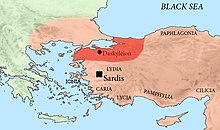
Some time in the 540s BC, Phrygia passed to the Achaemenid (Great Persian) Empire when Cyrus the Great conquered Lydia.
After Darius the Great became Persian Emperor in 521 BC, he remade the ancient trade route into the Persian "Royal Road" and instituted administrative reforms that included setting up satrapies. The Phrygian satrapy (province) lay west of the Halys River (now Kızıl River) and east of Mysia and Lydia. Its capital was established at Dascylium, modern Ergili.
In the course of the 5th century, the region was divided in two administrative satrapies: Hellespontine Phrygia and Greater Phrygia.[33]
Under Alexander and his successors[]
The Macedonian Greek conqueror Alexander the Great passed through Gordium in 333 BC and severed the Gordian Knot in the temple of Sabazios ("Zeus"). According to a legend, possibly promulgated by Alexander's publicists, whoever untied the knot would be master of Asia. With Gordium sited on the Persian Royal Road that led through the heart of Anatolia, the prophecy had some geographical plausibility. With Alexander, Phrygia became part of the wider Hellenistic world. Upon Alexander's death in 323 BC, the Battle of Ipsus took place in 301 BC.[34]
Celts and Attalids[]
In the chaotic period after Alexander's death, northern Phrygia was overrun by Celts, eventually to become the province of Galatia. The former capital of Gordium was captured and destroyed by the Gauls soon afterwards and disappeared from history.
In 188 BC, the southern remnant of Phrygia came under the control of the Attalids of Pergamon. However, the Phrygian language survived, although now written in the Greek alphabet.
Under Rome and Byzantium[]

In 133 BC, the remnants of Phrygia passed to Rome. For purposes of provincial administration, the Romans maintained a divided Phrygia, attaching the northeastern part to the province of Galatia and the western portion to the province of Asia. There is some evidence that western Phrygia and Caria were separated from Asia in 254–259 to become the new province of Phrygia and Caria.[35] During the reforms of Diocletian, Phrygia was divided anew into two provinces: "Phrygia I", or Phrygia Salutaris (meaning "healthy" in Latin), and Phrygia II, or Pacatiana (Greek Πακατιανή, "peaceful"), both under the Diocese of Asia. Salutaris with Synnada as its capital comprised the eastern portion of the region and Pacatiana with Laodicea on the Lycus as capital of the western portion. The provinces survived up to the end of the 7th century, when they were replaced by the Theme system. In the Late Roman, early "Byzantine" period, most of Phrygia belonged to the Anatolic theme. It was overrun by the Turks in the aftermath of the Battle of Manzikert (1071).[36] The Turks had taken complete control in the 13th century, but the ancient name of Phrygia remained in use until the last remnant of the Byzantine Empire was conquered by the Ottoman Empire in 1453.
Culture[]
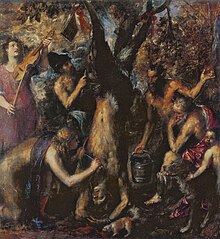
The ruins of Gordion and Midas City prove that Phrygia had developed an advanced Bronze Age culture. This Phrygian culture interacted in a number of ways with Greek culture in various periods of history.[2]
The "Great Mother", Cybele, as the Greeks and Romans knew her, was originally worshiped in the mountains of Phrygia, where she was known as "Mountain Mother". In her typical Phrygian form, she wears a long belted dress, a polos (a high cylindrical headdress), and a veil covering the whole body. The later version of Cybele was established by a pupil of Phidias, the sculptor Agoracritus, and became the image most widely adopted by Cybele's expanding following, both in the Aegean world and at Rome. It shows her humanized though still enthroned, her hand resting on an attendant lion and the other holding the tympanon, a circular frame drum, similar to a tambourine.
The Phrygians also venerated Sabazios, the sky and father-god depicted on horseback. Although the Greeks associated Sabazios with Zeus, representations of him, even in Roman times, show him as a horseman god. His conflicts with the indigenous Mother Goddess, whose creature was the Lunar Bull, may be surmised in the way that Sabazios' horse places a hoof on the head of a bull, in a Roman relief at the Museum of Fine Arts, Boston.

The earliest traditions of Greek music derived from Phrygia, transmitted through the Greek colonies in Anatolia, and included the Phrygian mode, which was considered to be the warlike mode in ancient Greek music. Phrygian Midas, the king of the "golden touch", was tutored in music by Orpheus himself, according to the myth. Another musical invention that came from Phrygia was the aulos, a reed instrument with two pipes.
Marsyas, the satyr who first formed the instrument using the hollowed antler of a stag, was a Phrygian follower of Cybele. He unwisely competed in music with the Olympian Apollo and inevitably lost, whereupon Apollo flayed Marsyas alive and provocatively hung his skin on Cybele's own sacred tree, a pine. Phrygia was also the scene of another musical contest, between Apollo and Pan. Midas was either a judge or spectator, and said he preferred Pan's pipes to Apollo's lyre, and was given donkey's ears as a punishment. The two stories were often confused or conflated, as by Titian.

Classical Greek iconography identifies the Trojan Paris as non-Greek by his Phrygian cap, which was worn by Mithras and survived into modern imagery as the "Liberty cap" of the American and French revolutionaries. The Phrygians spoke an Indo-European language. (See Phrygian language.) Although the Phrygians adopted the alphabet originated by the Phoenicians, only a few dozen inscriptions in the Phrygian language have been found, primarily funereal, and so much of what is thought to be known of Phrygia is second-hand information from Greek sources.
Mythic past[]
The name of the earliest known mythical king was Nannacus (aka Annacus).[37] This king resided at Iconium, the most eastern city of the kingdom of Phrygia at that time; and after his death, at the age of 300 years, a great flood overwhelmed the country, as had been foretold by an ancient oracle. The next king mentioned in extant classical sources was called Manis or Masdes. According to Plutarch, because of his splendid exploits, great things were called "manic" in Phrygia.[38] Thereafter, the kingdom of Phrygia seems to have become fragmented among various kings. One of the kings was Tantalus, who ruled over the north western region of Phrygia around Mount Sipylus. Tantalus was endlessly punished in Tartarus, because he allegedly killed his son Pelops and sacrificially offered him to the Olympians, a reference to the suppression of human sacrifice. Tantalus was also falsely accused of stealing from the lotteries he had invented. In the mythic age before the Trojan war, during a time of an interregnum, Gordius (or Gordias), a Phrygian farmer, became king, fulfilling an oracular prophecy. The kingless Phrygians had turned for guidance to the oracle of Sabazios ("Zeus" to the Greeks) at Telmissus, in the part of Phrygia that later became part of Galatia. They had been instructed by the oracle to acclaim as their king the first man who rode up to the god's temple in a cart. That man was Gordias (Gordios, Gordius), a farmer, who dedicated the ox-cart in question, tied to its shaft with the "Gordian Knot". Gordias refounded a capital at Gordium in west central Anatolia, situated on the old trackway through the heart of Anatolia that became Darius's Persian "Royal Road" from Pessinus to Ancyra, and not far from the River Sangarius.

The Phrygians are associated in Greek mythology with the Dactyls, minor gods credited with the invention of iron smelting, who in most versions of the legend lived at Mount Ida in Phrygia.
Gordias's son (adopted in some versions) was Midas. A large body of myths and legends surround this first king Midas.[39] connecting him with a mythological tale concerning Attis.[40] This shadowy figure resided at Pessinus and attempted to marry his daughter to the young Attis in spite of the opposition of his lover Agdestis and his mother, the goddess Cybele. When Agdestis and/or Cybele appear and cast madness upon the members of the wedding feast. Midas is said to have died in the ensuing chaos.
King Midas is said to have associated himself with Silenus and other satyrs and with Dionysus, who granted him a "golden touch".
In one version of his story, Midas travels from Thrace accompanied by a band of his people to Asia Minor to wash away the taint of his unwelcome "golden touch" in the river Pactolus. Leaving the gold in the river's sands, Midas found himself in Phrygia, where he was adopted by the childless king Gordias and taken under the protection of Cybele. Acting as the visible representative of Cybele, and under her authority, it would seem, a Phrygian king could designate his successor.
The Phrygian Sibyl was the priestess presiding over the at Phrygia.
According to Herodotus,[41] the Egyptian pharaoh Psammetichus II had two children raised in isolation in order to find the original language. The children were reported to have uttered bekos, which is Phrygian for "bread", so Psammetichus admitted that the Phrygians were a nation older than the Egyptians.
Christian period[]
Visitors from Phrygia were reported to have been among the crowds present in Jerusalem on the occasion of Pentecost as recorded in Acts 2:10. In Acts 16:6 the Apostle Paul and his companion Silas travelled through Phrygia and the region of Galatia proclaiming the Christian gospel. Their plans appear to have been to go to Asia but circumstances or guidance, "in ways which we are not told, by inner promptings, or by visions of the night, or by the inspired utterances of those among their converts who had received the gift of prophecy" [42] prevented them from doing so and instead they travelled westwards towards the coast.[43]
The Christian heresy known as Montanism, and still known in Orthodoxy as "the Phrygian heresy", arose in the unidentified village of Ardabau in the 2nd century AD, and was distinguished by ecstatic spirituality and women priests. Originally described as a rural movement, it is now thought to have been of urban origin like other Christian developments. The new Jerusalem its adherents founded in the village of Pepouza has now been identified in a remote valley that later held a monastery.[2]
See also[]
- Ancient regions of Anatolia
- Phrygians
- Bryges
- Paleo-Balkan languages
- Phrygian cap
- Phrygian language
References[]
- ^ "Archaeologists discover lost city that may have conquered the kingdom of Midas".
- ^ Jump up to: a b c d e Peter Thonemann (ed), 2013, Roman Phrygia: culture and society, Cambridge University Press
- ^ Herodotus VII.73.
- ^ Herodotus VII.73, VIII.138.
- ^ Strabo 7.3.3.
- ^ Jump up to: a b Homeric Hymns number 5, To Aphrodite.
- ^ Claude Brixhe, Phrygian, in Roger D. Woodard (editor), The ancient Languages of Asia Minor, Cambridge University Press, 2008, p. 72
- ^ Bolaris, Miltiades E. (2010). "Midas and the Phrygians".
- ^ Jump up to: a b Hamp, Eric P. (August 2013). "The Expansion of the Indo-European Languages: An Indo-Europeanist's Evolving View" (PDF). Sino-Platonic Papers. 239: 8, 10. Retrieved 25 July 2014.
- ^ Celtic from the West, 2010
- ^ See for example Encyclopædia Britannica.
- ^ Phillip Clapham, "Hittites and Phrygians", C&AH IV:2, pp.71–121.
- ^ Pausanias 1.4.5.
- ^ CAH, Vol 2, Part 2, p. 418.
- ^ I. M. Diakonoff, The Pre-History of the Armenian People (revised, trans. Lori Jennings), Caravan Books, New York (1984), ISBN 0-88206-039-2.
- ^ Hamp, Eric P. (August 2013). "The Expansion of the Indo-European Languages: An Indo-Europeanist's Evolving View" (PDF). Sino-Platonic Papers. 239: 8, 10, 13. Archived (PDF) from the original on 2 August 2019.
- ^ Armen Petrosyan (January 1, 2007). The Problem Of Identification Of The Proto-Armenians: A Critical Review. Society For Armenian Studies. pp. 49–54. Archived from the original on 4 October 2020. Retrieved 23 November 2018.
- ^ Martirosyan, Hrach (2014). "Origins and Historical Development of the Armenian Language" (PDF). Leiden University. pp. 1–23. Archived (PDF) from the original on 4 August 2019. Retrieved 5 August 2019.
- ^ "The Mushki Problem Reconsidered". Archived from the original on 28 August 2020. Retrieved 24 March 2021.
- ^ Bartomeu Obrador Cursach. "On the place of Phrygian among the Indo-European languages." Journal of Language Relationship. 2019. https://www.academia.edu/42660767/On_the_place_of_Phrygian_among_the_Indo_European_languages
- ^ Clackson, J. P. T., 2008, “Classical Armenian”, in Woodard,R. D., The Ancient Languages of Asia Minor, Cambridge, Cambridge University Press, 124–143
- ^ Martirosyan, H., 2013, “The place of Armenian in the Indo-European language family: the relationship with Greek and Indo-Iranian”, Journal of Language Relationship10, 85—13
- ^ Hamp, Eric P. (August 2013). "The Expansion of the Indo-European Languages: An Indo-Europeanist's Evolving View" (PDF). Sino-Platonic Papers.
- ^ Kim, Ronald (2018). "Greco-Armenian: The persistence of a myth". Indogermanische Forschungen. The University of British Columbia Library.
- ^ "On the place of Phrygian among the Indo-European languages." Journal of Language Relationship. 2019. https://www.academia.edu/42660767/On_the_place_of_Phrygian_among_the_Indo_European_languages
- ^ Homer, Iliad III.216–225.
- ^ Homer, Iliad II.1055–1057; Smith, William (1878). A Dictionary of Greek and Roman Geography. London: J. Murray. p. 230.
- ^ Pausanias 10.27
- ^ Bibliotheca 2.5.10.
- ^ Homer, Iliad XVI.873–875.
- ^ Strabo, I.3.21.
- ^ Encyclopædia Britannica.
- ^ Scott 1995, p. 183.
- ^ "Kingdoms of the Successors of Alexander: After the Battle of Ipsus, B.C. 301". World Digital Library. 1800–1884. Retrieved 2013-07-27.
- ^ van Kuijck, Joey (2016). Shaping the Dioceses of Asiana and Africa in Late Antiquity (PDF). p. 27. Retrieved 29 May 2021.
- ^ Swain, Simon; Adams, J. Maxwell; Janse, Mark (2002). Bilingualism in ancient society: language contact and the written word. Oxford [Oxfordshire]: Oxford University Press. pp. 246–266. ISBN 0-19-924506-1.
- ^ Suidas s. v. Νάννακος; Stephanus of Byzantium s.v. Ἰκόνιον; Both passages are translated in: A new system: or, An analysis of ancient mythology by Jacob Bryant (1807) pp. 12–14
- ^ Plutarch, On Isis and Osiris, Chapter 24
- ^ There were seven all together
- ^ Pausanias Description of Greece 7:17; Arnobius Against the Pagans 5.5
- ^ Histories 2.9
- ^ Ellicott's Commentary for English Readers, accessed 18 September 2015
- ^ Acts 16:7–8
Bibliography[]
- Scott, James M. (1995). Paul and the Nations: The Old Testament and Jewish Background of Paul's Mission to the Nations with Special Reference to the Destination of Galatians. Mohr Siebeck. ISBN 978-3161463778.
- Thonemann, Peter, ed. (2013). Roman Phrygia: culture and society. Cambridge: Cambridge University Press. ISBN 978-1-107-03128-9.
- Tamsü, Rahşan; Polat, Yusuf (February 19–24, 2007). "The Phrygian rock cut altars and their restoration and conservation proposals". International Conference on Environment: Survival and Sustainability (EES 2007). Nicosia, Northern Cyprus (published 2009). 3: 1005–1014. ISBN 978-975-8359-55-4.
- Tamsü, Rahşan (February 24–26, 2005). "Observations on the Phrygian rock-cut altars". Symposium on Mediterranean Archaeology (SOMA 2005). Chieti-Pescara, Italy: Chieti University (published 2008): 439–445. ISBN 978-1-4073-0181-5.
- Tamsü, Rahşan; Polat, Yusuf (2010). "Yeni Buluntular Işığında Phryg Kaya Altarları Ve Bir Tipoloji Önerisi". Anadolu Üniversitesi Sosyal Bilimler Dergisi (in Turkish). Eskişehir. 10 (1): 203–222. ISSN 1303-0876.
External links[]
| Wikimedia Commons has media related to Phrygia. |
- "Phrygia". Ancient History Encyclopedia. Archived from the original on 2010-11-19. Retrieved 2010-06-10.
- "Phrygian Period in Anatolia". Ancient Anatolia. Archived from the original on 6 December 2006.
- Ramsay, William Mitchell (1911). . Encyclopædia Britannica. 21 (11th ed.). pp. 541–544.
- "King Midas and Phrygia Cultural Center". Archived from the original on 20 July 2010.
Coordinates: 39°N 31°E / 39°N 31°E
- Phrygia
- States and territories established in the 12th century BC
- States and territories disestablished in the 7th century BC
- Historical regions of Anatolia
- Pauline churches
- History of Ankara Province
- History of Afyonkarahisar Province
- History of Eskişehir Province

